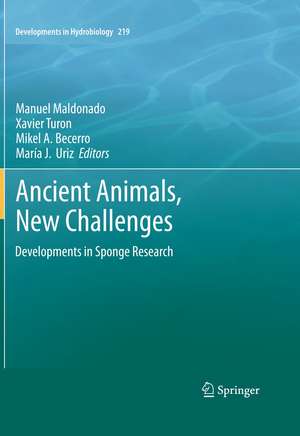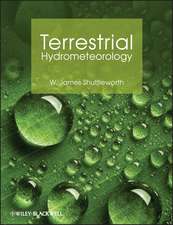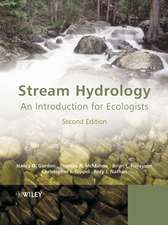Ancient Animals, New Challenges: Developments in Sponge Research: Developments in Hydrobiology, cartea 219
Editat de Manuel Maldonado, Xavier Turon, Mikel A. Becerro, Maria Jesús Urizen Limba Engleză Hardback – 7 aug 2012
Previously published in Hydrobiologia, vol. 687, 2012
| Toate formatele și edițiile | Preț | Express |
|---|---|---|
| Paperback (1) | 800.39 lei 38-44 zile | |
| SPRINGER NETHERLANDS – 23 aug 2016 | 800.39 lei 38-44 zile | |
| Hardback (1) | 818.24 lei 38-44 zile | |
| SPRINGER NETHERLANDS – 7 aug 2012 | 818.24 lei 38-44 zile |
Din seria Developments in Hydrobiology
- 18%
 Preț: 1229.10 lei
Preț: 1229.10 lei - 18%
 Preț: 959.98 lei
Preț: 959.98 lei - 18%
 Preț: 963.91 lei
Preț: 963.91 lei - 15%
 Preț: 648.24 lei
Preț: 648.24 lei - 15%
 Preț: 637.89 lei
Preț: 637.89 lei -
 Preț: 378.25 lei
Preț: 378.25 lei - 15%
 Preț: 644.95 lei
Preț: 644.95 lei - 18%
 Preț: 952.09 lei
Preț: 952.09 lei - 20%
 Preț: 558.87 lei
Preț: 558.87 lei - 18%
 Preț: 1833.65 lei
Preț: 1833.65 lei -
 Preț: 393.59 lei
Preț: 393.59 lei -
 Preț: 406.54 lei
Preț: 406.54 lei - 18%
 Preț: 1226.73 lei
Preț: 1226.73 lei - 18%
 Preț: 956.99 lei
Preț: 956.99 lei -
 Preț: 388.87 lei
Preț: 388.87 lei - 24%
 Preț: 1060.53 lei
Preț: 1060.53 lei - 18%
 Preț: 1229.28 lei
Preț: 1229.28 lei - 20%
 Preț: 569.31 lei
Preț: 569.31 lei -
 Preț: 368.79 lei
Preț: 368.79 lei - 24%
 Preț: 817.48 lei
Preț: 817.48 lei - 18%
 Preț: 958.25 lei
Preț: 958.25 lei - 18%
 Preț: 953.03 lei
Preț: 953.03 lei -
 Preț: 384.75 lei
Preț: 384.75 lei - 24%
 Preț: 1582.95 lei
Preț: 1582.95 lei - 24%
 Preț: 1051.70 lei
Preț: 1051.70 lei - 18%
 Preț: 943.57 lei
Preț: 943.57 lei - 18%
 Preț: 1235.76 lei
Preț: 1235.76 lei - 24%
 Preț: 800.05 lei
Preț: 800.05 lei - 24%
 Preț: 803.57 lei
Preț: 803.57 lei - 18%
 Preț: 948.29 lei
Preț: 948.29 lei
Preț: 818.24 lei
Preț vechi: 1076.64 lei
-24% Nou
Puncte Express: 1227
Preț estimativ în valută:
156.56€ • 163.48$ • 129.29£
156.56€ • 163.48$ • 129.29£
Carte tipărită la comandă
Livrare economică 11-17 aprilie
Preluare comenzi: 021 569.72.76
Specificații
ISBN-13: 9789400746879
ISBN-10: 9400746873
Pagini: 354
Ilustrații: VI, 351 p.
Dimensiuni: 193 x 260 x 20 mm
Ediția:2012
Editura: SPRINGER NETHERLANDS
Colecția Springer
Seria Developments in Hydrobiology
Locul publicării:Dordrecht, Netherlands
ISBN-10: 9400746873
Pagini: 354
Ilustrații: VI, 351 p.
Dimensiuni: 193 x 260 x 20 mm
Ediția:2012
Editura: SPRINGER NETHERLANDS
Colecția Springer
Seria Developments in Hydrobiology
Locul publicării:Dordrecht, Netherlands
Public țintă
ResearchCuprins
1. No longer Demospongiae.- 2. Molecular phylogeny of glass sponges.- 3. Phylogenetic reconstruction of Polymastiidae based on morphology.- 4. First evidence of miniature transposable elements in sponges.- 5. The mitochondrial genome of stygobitic sponge Eunapius subterraneus.- 6. The complete mitochondrial genome of the verongid sponge Aplysina cauliformis.- 7. Genetic structure and differentiation at a short-time scale of the introduced calcarean sponge.- 8. Paraleucilla magna to the western Mediterranean.- 9. Relationship between genetic, chemical, and bacterial diversity in the Atlanto-Mediterranean bath sponge Spongia lamella.- 10. First evaluation of mitochondrial DNA as a marker for phylogeographic studies of Calcarea.- 11. Diversity patterns and zoogeography of the Northeast Atlantic and Mediterranean shallow-water sponge fauna.- 12. Living on the edge.- 13. Sponge gardens of Ningaloo Reef are biodiversity hotspots.- 14. Role of deep sponge grounds in the Mediterranean Sea.- 15. Mangrove and coral reef sponge faunas.- 16. Qualitative variation in colour morphotypes of Ianthella basta- 17. Phenotypic variability in the Caribbean Orange Icing sponge Mycale laevis (Demospongiae: Poecilosclerida).- 18. Growth and regeneration of the elephant ear sponge Ianthella basta.- 19. The marine sponge Ianthella basta can recover from stress-induced tissue regression.- 20. Nutrient utilisation by shallow water temperate sponges in New Zealand.- 21. Experimental silicon demand by the sponge Hymeniacidon perlevis reveals chronic limitation in field Populations.- 22. Biosilica deposition in the marine sponge Petrosia fi ciformis- 23. Trace metal concentrations in the tropical sponge Spheciospongia vagabunda at a sewage outfall.- 24. Does concentrating chemical defenses within specific regions of marine sponges result in enhanced protection from predators?.- 25. Temporal variations in growth and reproduction of Tedania anhelans and Chondrosia reniformis in the North Adriatic Sea.- 26. Reproductive traits explain contrasting ecological features in sponges.- 27. Epibiont–basibiont interactions.- 28. Deep sequencing reveals diversity and community structure of complex microbiota in five Mediterranean sponges.
Textul de pe ultima copertă
This book summarizes the latest advances in sponge science through a concise selection of studies presented at the VIII World Sponge Conference. The collection of articles reflects hot, ongoing debates in molecular research, such as the monophyletic versus paraphyletic nature of the sponge group, or the new awareness on pros and cons of standard barcodes and other markers in sponge taxonomy and phylogeny. It also features articles showing how the new sequencing technologies reveal the functional and phylogenetic complexity of the "microbial universe" associated to sponge tissues. The ecological interactions of sponges, the effects of nutrients and pollutants, the variability in reproductive patterns, and the processes generating genotypic and phenotypic variability in sponge populations are covered in several contributions. Zoogeography, population structure and dynamics are also approached with both traditional and molecular tools. The effect of anthropogenic disturbance on the natural environment finds its place in this volume with papers dealing with metal accumulation and the potential role of sponges as biomonitors. Biodiversity data from unexplored tropical and deep sea areas are presented. We hope readers will enjoy the selection of papers, which we believe represent collectively a significant contribution to our current understanding of sponges.
Previously published in Hydrobiologia, vol. 687, 2012
Previously published in Hydrobiologia, vol. 687, 2012
Caracteristici
Features continuing discussions in molecular research Includes a diversity of approaches (phylogeny, ecology, molecular ecology, biotechnology) Presents biodiversity data from unknown tropical and deep sea areas. Describes anthropogenic disturbance effects on the natural environment?





